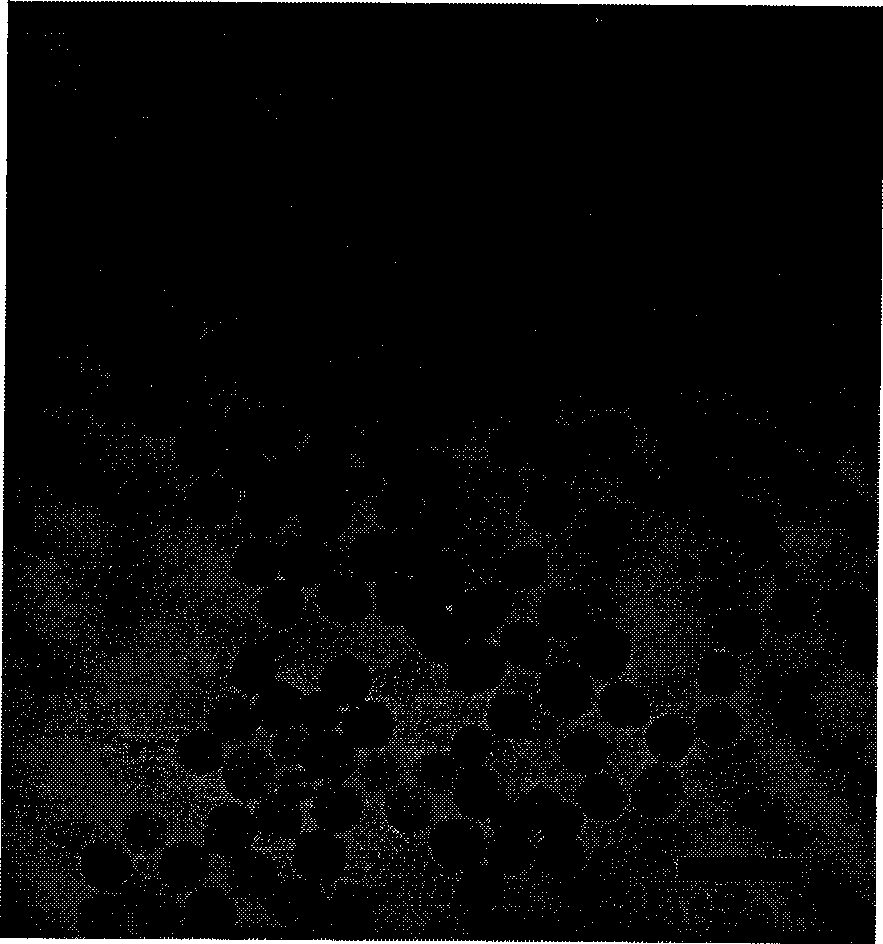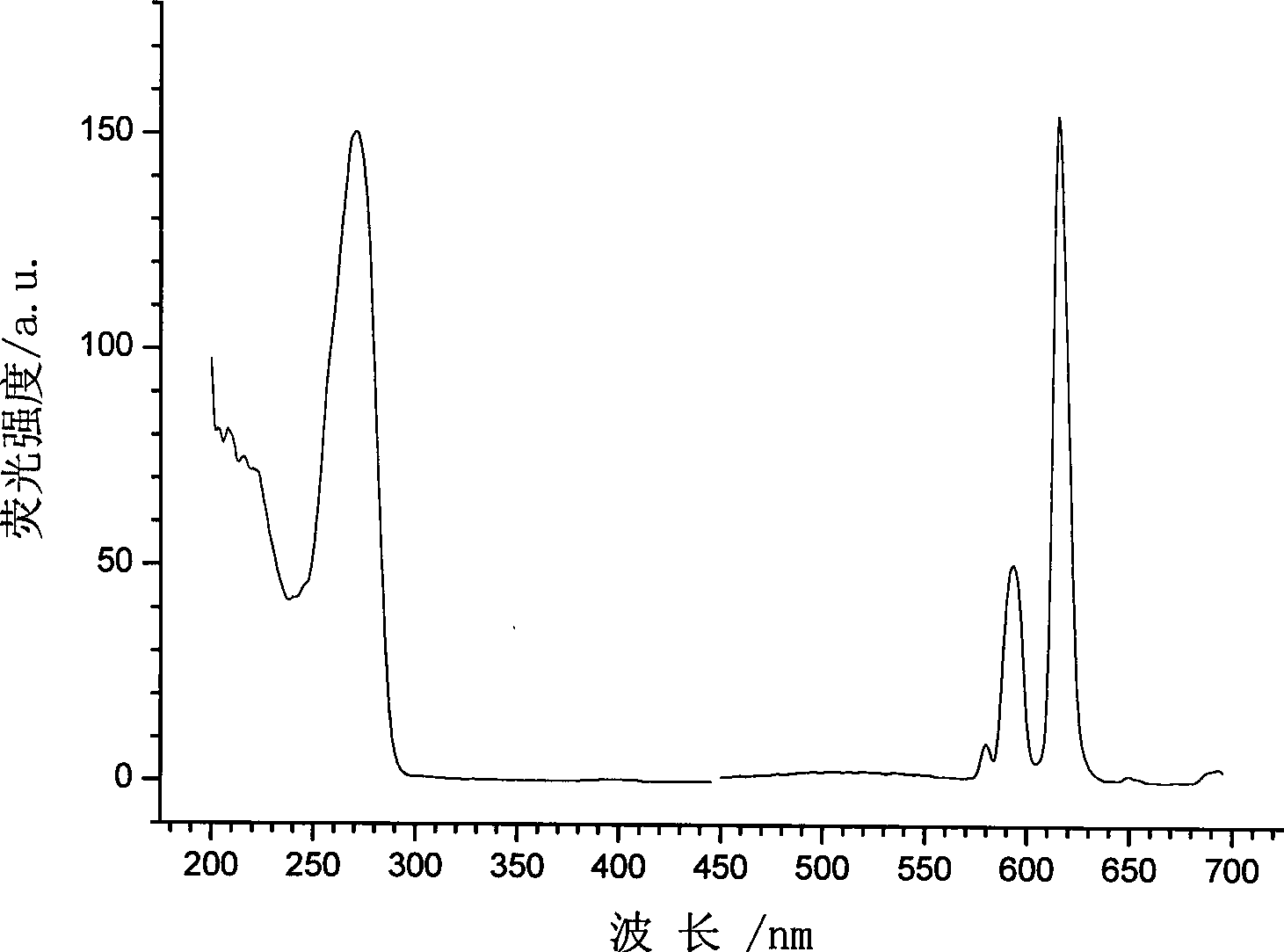Preparation of rare earth luminous nanoparticle based on pyridine dicarboxylic acid
A technology of dipicolinic acid and nanoparticles, applied in the direction of luminescent materials, chemical instruments and methods, measuring devices, etc., can solve problems such as unsatisfactory dispersion, no commercial source, complex organic synthesis, etc., to avoid complex organic synthesis, Good water solubility and stability, good water solubility effect
- Summary
- Abstract
- Description
- Claims
- Application Information
AI Technical Summary
Problems solved by technology
Method used
Image
Examples
Embodiment 1
[0030] Embodiment 1: Preparation of dipicolinic acid-Eu nanoparticles modified by oligonucleotide probes
[0031] Preparation of rare earth complexes: the rare earth Eu 3+ Aqueous solution (Eu 3+ Hydrochloride) and dipicolinic acid solution were mixed and reacted for 10 minutes at a molar ratio of 1:3.
[0032] Preparation of rare earth nanoparticles: Mix cyclohexanone, n-hexanol and Triton X-100 (v / v, 4:1:1) and stir evenly, add an appropriate amount of rare earth complex solution (water phase), and stir fully to form an oil-coated After the water microemulsion, add tetraethyl orthosilicate and concentrated ammonia water, and after stirring for 2 hours, add aminopropyltriethoxysilane (aminosilylating agent), and react the reaction mixture for 20 hours under stirring. After the reaction is completed, the milky white Add an appropriate amount of acetone to the suspension for centrifugal sedimentation, wash with ethanol and water to remove the reaction solution, and centrifuge...
Embodiment 2
[0034] Embodiment 2: Preparation of dipicolinic acid-Tb nanoparticles
[0035] Preparation of rare earth complexes: the rare earth Tb 3+ Aqueous solution (Tb 3+ Nitrate or hydrochloride) and dipicolinic acid solution were mixed and reacted for 10 minutes at a molar ratio of 1:3.
[0036] Preparation of rare earth nanoparticles: Mix cyclohexanone, n-hexanol and Triton X-100 (v / v, 4:1:1) and stir evenly, add an appropriate amount of rare earth complex solution (water phase), and stir fully to form an oil-coated After the water microemulsion, add tetraethyl orthosilicate and concentrated ammonia water, stir for 2 hours, add aminopropyltriethoxysilane (silylating agent), and react the reaction mixture for 20 hours under stirring. After the reaction is completed, it will be suspended in milky white A proper amount of acetone was added to the solution for centrifugal sedimentation, washed with ethanol and water respectively to remove the reaction solution, and centrifuged to obtai...
Embodiment 3
[0037] Embodiment 3: Preparation of dipicolinic acid-Dy nanoparticles
[0038] Preparation of rare earth complexes: the rare earth Dy 3+ Aqueous solution (Dy 3+ Hydrochloride) and dipicolinic acid solution were mixed and reacted for 10 minutes at a molar ratio of 1:3.
[0039] Preparation of rare earth nanoparticles: Mix cyclohexanone, n-hexanol and Triton X-100 (v / v, 4:1:1) and stir evenly, add an appropriate amount of rare earth complex solution (water phase), and stir fully to form an oil-coated After the water microemulsion, add tetraethyl orthosilicate and concentrated ammonia water, stir for 2 hours, add aminopropyltriethoxysilane (silylating agent), and react the reaction mixture for 20 hours under stirring. After the reaction is completed, it will be suspended in milky white A proper amount of acetone was added to the solution for centrifugal sedimentation, washed with ethanol and water respectively to remove the reaction solution, and centrifuged to obtain SiO 2 Th...
PUM
 Login to View More
Login to View More Abstract
Description
Claims
Application Information
 Login to View More
Login to View More - R&D
- Intellectual Property
- Life Sciences
- Materials
- Tech Scout
- Unparalleled Data Quality
- Higher Quality Content
- 60% Fewer Hallucinations
Browse by: Latest US Patents, China's latest patents, Technical Efficacy Thesaurus, Application Domain, Technology Topic, Popular Technical Reports.
© 2025 PatSnap. All rights reserved.Legal|Privacy policy|Modern Slavery Act Transparency Statement|Sitemap|About US| Contact US: help@patsnap.com



